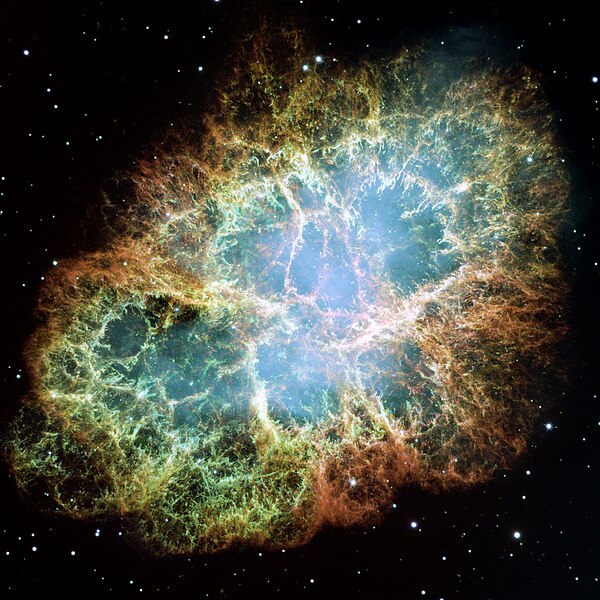Tiedosto:Crab Nebula.jpg

Tämän esikatselun koko: 600 × 600 kuvapistettä. Muut resoluutiot: 240 × 240 kuvapistettä | 480 × 480 kuvapistettä | 768 × 768 kuvapistettä | 1 024 × 1 024 kuvapistettä | 2 048 × 2 048 kuvapistettä | 3 864 × 3 864 kuvapistettä.
Alkuperäinen tiedosto (3 864 × 3 864 kuvapistettä, 13,84 MiB, MIME-tyyppi: image/jpeg)
Tiedoston historia
Päiväystä napsauttamalla näet, millainen tiedosto oli kyseisellä hetkellä.
| Päiväys | Pienoiskuva | Koko | Käyttäjä | Kommentti | |
|---|---|---|---|---|---|
| nykyinen | 25. marraskuuta 2012 kello 16.56 |  | 3 864 × 3 864 (13,84 MiB) | Hawky.diddiz | Lossless optimization |
| 17. toukokuuta 2012 kello 12.13 |  | 3 864 × 3 864 (14,61 MiB) | Metrónomo | Higher quality | |
| 20. kesäkuuta 2009 kello 11.31 |  | 3 864 × 3 864 (6,18 MiB) | Tryphon | Higher resolution. | |
| 9. maaliskuuta 2006 kello 23.26 |  | 2 224 × 2 212 (3,08 MiB) | Stianbh | larger version | |
| 16. tammikuuta 2006 kello 02.35 |  | 400 × 400 (23 KiB) | DragonFire1024 | Image: A New View of the Helix Nebula Source: http://hubblesite.org/gallery/album/entire_collection/pr2004032d/ Copyright Notice: Material credited to STScI on this site was created, authored, and/or prepared for NASA under Contract NAS5-26555. Unless |
Tiedoston käyttö
Seuraavat 6 sivua käyttävät tätä tiedostoa:
Tiedoston järjestelmänlaajuinen käyttö
Seuraavat muut wikit käyttävät tätä tiedostoa:
- Käyttö sivustolla af.wikipedia.org
- 1054
- Wikipedia:Uitgesoekte herdenkings/22 April
- Wikipedia:Uitgesoekte herdenkings/Julie
- Wikipedia:Uitgesoekte herdenkings/April
- Wikipedia:Uitgesoekte herdenkings/4 Julie
- Supernova
- Ster
- Wikipedia:Beeld van die week/2012
- Wikipedia:Voorbladbeeld week 2 2012
- Newel
- Kompakte ster
- Veranderlike ster
- Lys van Messier-voorwerpe
- Krapnewel
- Portaal:Sterrekunde/Inleiding
- Portaal:Sterrekunde
- Hemelliggaam
- Lys van planetêre newels
- SN 1054
- Supernova-oorblyfsel
- Sterevolusie
- Käyttö sivustolla als.wikipedia.org
- Käyttö sivustolla am.wikipedia.org
- Käyttö sivustolla anp.wikipedia.org
- Käyttö sivustolla ar.wikipedia.org
- مجرة
- نجم
- سنة
- تطور النجوم
- ثلاثي الكربون
- فجر
- مستعر أعظم
- بوابة:علم الفلك/مقالة مختارة
- شهاب
- مطلع مستقيم
- جمعية منسا الدولية
- علم الفلك خارج المجري
- عنقود نجمي
- فيلا (أقمار اصطناعية)
- الشلياق
- خرزات بيلي
- راية الأرض
- سمت
- نظرية الحالة الثابتة
- توهج القمر الصناعي
- بوابة:الفيزياء/بوابات ذات علاقة
- الظهر
- اقتران (علم الفلك)
- علم الهيئة
- مقراب راديوي
Näytä lisää tämän tiedoston järjestelmänlaajuista käyttöä.

